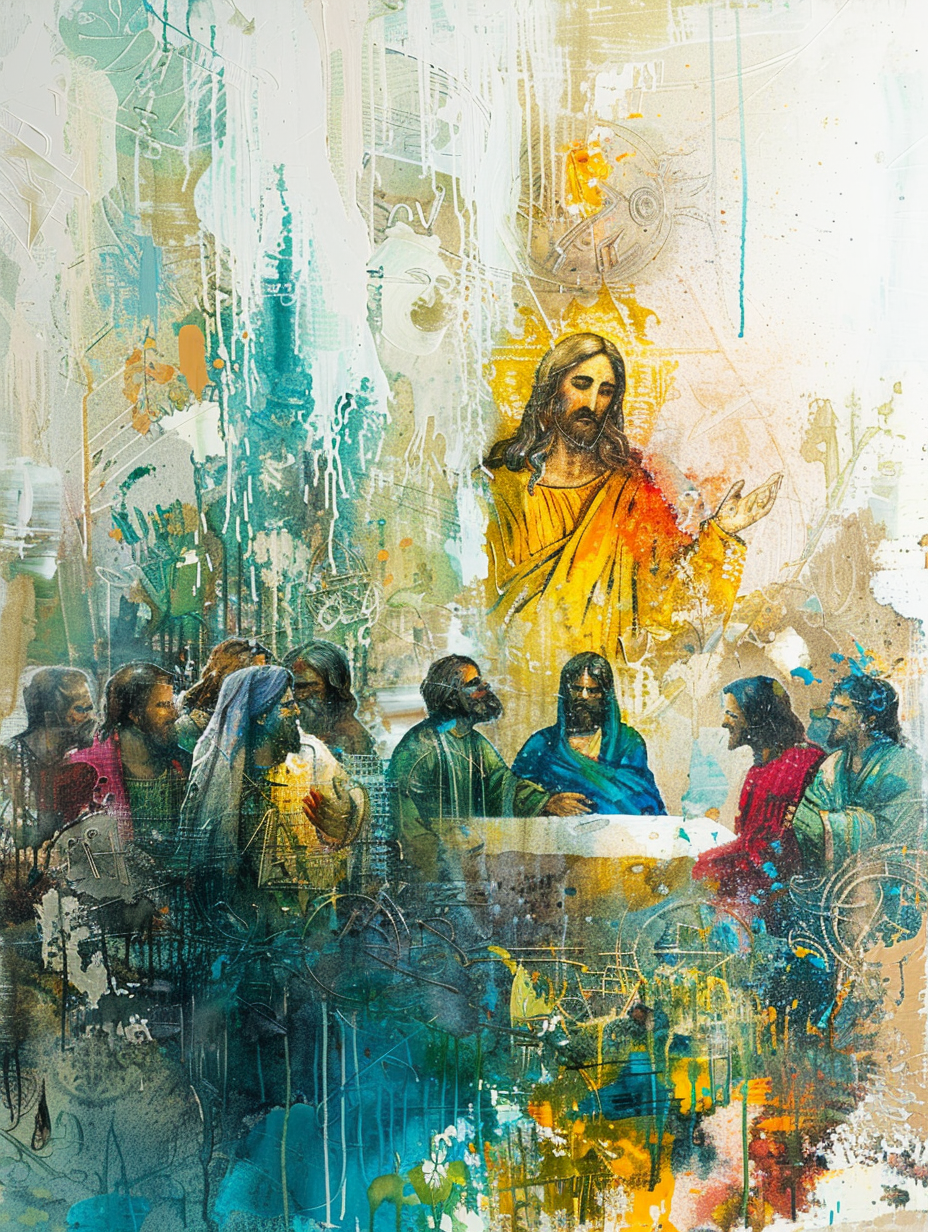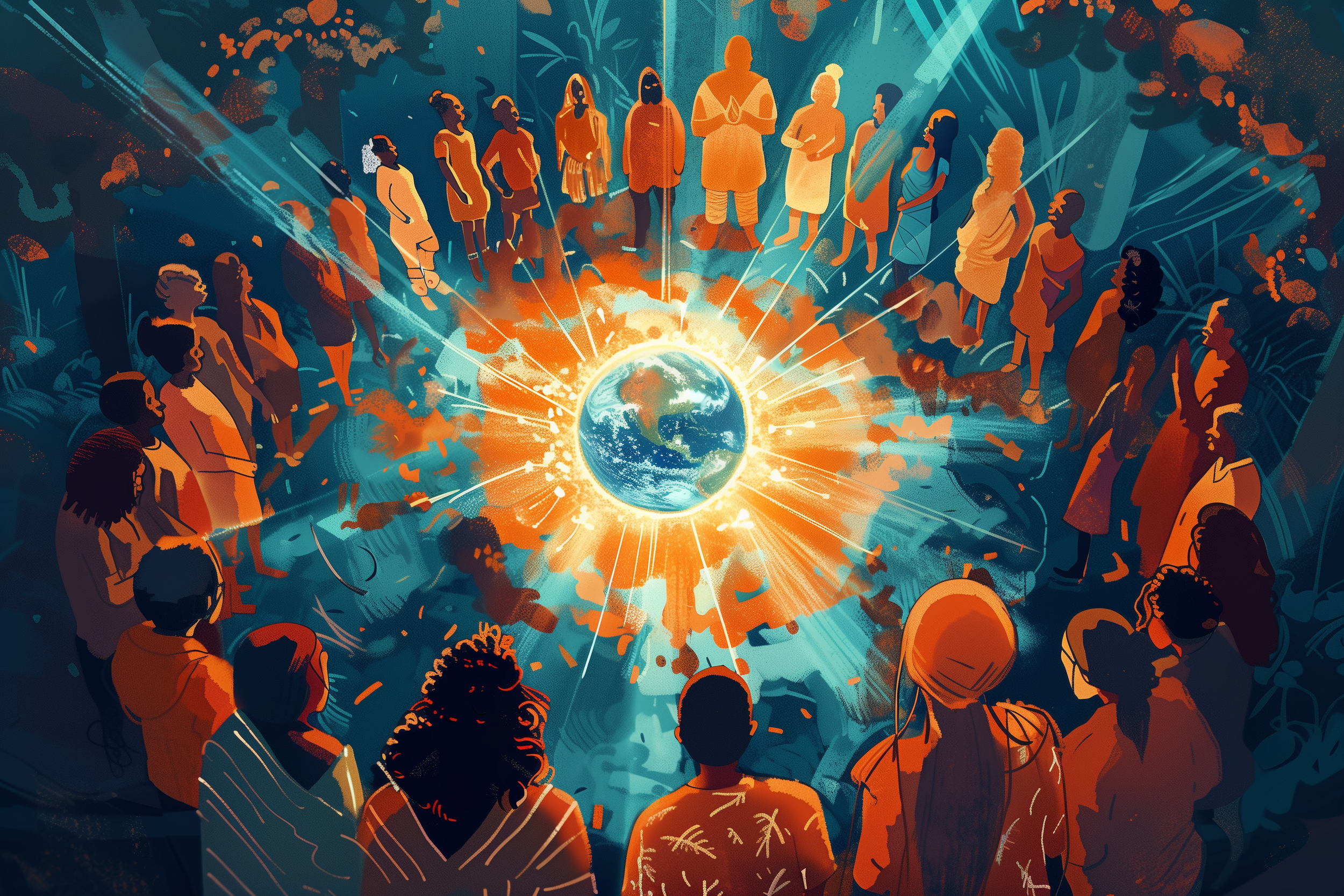Can Praying Change the World?
Following our Lenten season holding grief and glory, we continue with special emphasis on our global awareness and participation in wholeness that encompasses the whole earth.
We revisit a five-part series on Mystical Activism written by Paul Smith in 2020, to invite us into learning and becoming—into transformation with the world.
“Holding the World in Prayer” – image by Paul Fryer
Mystical Activism
Part One
Have you ever cried out to God or the Universe to do something about the horrible wars on earth or the increasing devastation of climate change? Maybe you have earnestly prayed about the starving populations around the world or the craziness of politicians today. Have you ever wondered if your prayer did any good? Maybe you’ve even given up on such types of prayer.
Does the world change when we pray? If so, how does that work? Do we ask God to do something, and then God acts? I believe praying does change the world, but it is not us asking and then God acting. Nor is it, as some have said, us asking, and then we act.
I believe this question is very much what Jesus had in mind when he said,
“Take this seriously: If two of you come into harmony on earth about any matter, you shall pray together, and it shall come into existence with you, along with my Abba, who dwells in the infinite consciousness of spirit.” (Matt. 18:19, my translation).
For those raised on the Bible, that may sound a little unfamiliar. Here’s why. New Testament translators have many shades of meaning for a biblical Greek word from which to choose, and their choice is naturally determined by their theology and consciousness. My theology is what might be called “progressive integral Christian.”
We’re going to go through some “heady” Greek translation stuff here, but reclaiming the words of Jesus by translating according to a more integral consciousness can really bring life and liberation to scriptures that have been stuck in traditional language too long!
So let’s look at this powerful statement from Jesus in that light.
“Coming into Harmony” by Dalmo Mendonça
Harmony
“If two of you come into harmony.” The Greek word sumphoneo here is commonly translated as “agree,” as in “If two of you agree.” Its historical roots are “to be in harmony,” such as with sounds and musical instruments, and we get the word “symphony” from it. “Agree” sounds like you take a vote and make a bargain, and then God does something. It’s much more like a symphony orchestra playing in beautiful accord together.
I believe Jesus was advocating that we connect in this way. “Come into harmony” catches the deeper sense of what happens when a group is together in its awakened heart space. The heart field integrates and provides coherence within each person, in their connections with others in the group, in the energy field of the group, and ultimately in the network the group is a part of.
So then, if we are in harmony, does that mean that God does something?
“Co-Creation” by Dalmo Mendonça
Co-Creating with God
“You may pray together, and it shall come into existence with you, along with my Abba who dwells in the infinite consciousness of spirit.”
The common translation is, “They may ask, and it shall be done for them by my Father who is in heaven.” That’s the “We ask and God does” understanding.
The Greek words ginomai and auto are commonly translated respectively as “be done” and “for them.” However, ginomai also means to “come into existence” or “appear in history.” This is what Wilber calls “cutting a cosmic groove.”
The Greek word autos is commonly translated as “for” them. However, αὐτοῖς can also be a dative of “instrument” (a phrase used to indicate that something is a means to something else) and therefore can mean “by” or “with” them. So I believe this is saying that when a group comes together in harmony, they can cocreate with one another and God, bringing forth a new path in the world’s consciousness. This is very real and powerful action on an invisible spiritual plane.
I also translate “my Father in heaven” as “my Abba (Daddy) who dwells in the infinite consciousness of spirit.” This makes clear that Jesus is speaking of the God who was always with him intimately as a spiritual presence and whom he called Abba or “Daddy” in his native Aramaic language. We tend to think of heaven as far up there in the sky. When Jesus talked to Abba Daddy, he didn’t need to shout. He was talking to his spiritual “Papa,” who was always warmly accessible to him in awakened consciousness, by his side, in immediate presence for guidance and actively involved in cocreation with him and now with us.
According to the 10-volume monumental Theological Dictionary of the New Testament, the Greek word for heaven in this passage is a “cosmic” word denoting a “complete lack of earthly or spatial restriction.” This is the realm of God that “knows all, sees all and is accessible to all.” This is called, by many of us today, “infinite consciousness,” and what the New Testament calls “spirit.” Because of the common understanding of heaven as a place, rather than a realm of consciousness, I translate “heaven” in an expanded way as “the infinite consciousness of spirit.”
“Dance the Cosmic Dance” by Dalmo Mendonça
Together, not alone
I also added the word “together” to “pray” since, in today’s world, when we think of prayer, we usually think of someone praying alone. Jesus is talking about a least two people here and emphasizes that when he says next:
“Where two or three are gathered together in my name, I am there with them in their midst” (Matt 18:20).
Of course, Jesus is with us all the time, alone and together with others. But here, he is pointing out this is a small group “gathered together in my name.” “My name” means as his followers who are aware of his mystical presence and love. He is there in a deeply powerful and transforming way. He is joining with his Abba Daddy and us in transmitting a new consciousness to the world that changes things! This is “togetherness” at the highest dimensions!
“Gathered Together” by Dalmo Mendonça
Mystical Activism
We can also call this Mystical Activism. It is the result of awakened consciousness in the presence of others in a dynamic collective of prayer, meditation, sacred ritual, visio divina (gazing at holy images), ecstatic movement, or prayer practices that, among other things, is intended to bring global healing and social change. Awakened or Spiritual Activism grows from the idea that there are other ways to positively influence social change in addition to overt political or social action.
Traditional methods of activism, such as marches, demonstrations, protests, lobbying, and voting campaigns, are the most obvious expressions of action for social change. And we still need them as past and recent history has shown us. However, there is more.
Mystical activism might appear from the outside to involve no apparent action or social change at all. However, this spiritual activity can be recognized as a legitimate and powerful form of social action in itself once we understand it this way: We are actively influencing the collective mind, which is entangled at subtle levels of consciousness in the non-local field in which all humans are embedded.
I point this out in order to directly name the connection between the inner world of spiritual practice and the outer world of social and political affairs. They are not separate.
In praying alone, outside of a physical or spiritual collective, we can also connect with our deeper nature and meditate or pray for world peace. But in mystical subtle activism, we connect with whatever collective we are part of to cocreate a much more vital, larger, powerful field of consciousness with the intention of changing the world.
We can feel this in our WeSpace groups when we begin meditative prayer. The atmosphere becomes enlivened in a felt way. These collectives can be socially transforming, even affecting the entire cosmos, cutting deeper and new cosmic groves. They can affect the collective psyche, out of which new ways of thinking, decision making, and actions emerge.
David Nicol, at the California Institute of Integral Studies, says that this kind of mystical activism is not just moving “up” toward a transcendent God, or “in” toward a personal spirituality, but also “out” into the world where we use our spiritual power and knowledge to mediate between the tribal unit and the wider community of being. There is enormous untapped power in these kinds of practices to support collective healing and social change.
Jungian scholar Marie-Louise von Franz says, “Whenever an individual works on his (sic) own unconscious, he invisibly affects first the group, and, if he goes even deeper, he affects the large national units or sometimes even all of humanity. Not only does he change and transform himself, but he has an imperceptible impact on the unconscious psyche of many other people.”
“Jesus Prays with Us” by Dalmo Mendonça
Decidedly “mystical”
Integral mystical activism is based on an integrated understanding of God and an integrated practice that is involved in what is commonly called the “mystical.” The word “mystical,” like “spiritual,” means different things for different people, from “woo-woo” to esotericism. Here we mean to emphasize the integration of the invisible spiritual realm that is interwoven with our visible physical universe.
Integral Christian mystical activism is prayer, meditation, ritual, or any other kind of spiritual or subtle and transcendent consciousness practice within a network of practitioners in the Christian tradition with the intention of moving “out” in social engagement.
Crucially, it includes the wisdom and cocreation between humans and guiding presences from subtle realms, just as Jesus relied on. The times are too crucial to ignore the wisdom from our elders and guides in the non-physical realm who are present to help us. For followers of Jesus, this includes Abba God, the presence of the Living Jesus himself, the saints, and other spiritual guides in the cloud of witnesses that surrounds us all
Why Jesus never prayed with his followers
Notice that when Jesus wanted to pray, he always went off by himself. “Then Jesus went with his disciples to a place called Gethsemane, and he said to them, “Sit here while I go over there and pray” (Matt 26:36). He never, ever, according to the Gospels, prayed with them. Why? It seems to me, Jesus knew that while praying for them was important, actually praying with them would have been vastly beyond their current stage of spiritual development.
As the spiritual training, while in his physical body, of his closest friends, was coming to an end, Jesus knew it was time to introduce his followers up to the breakthrough state of their inner spiritual development. This was critical if they were going to be effective in spreading his message. He said, “As Abba has sent me, I am sending you, and he breathed on them and said ‘Receive holy spirit’” (John 20:21-22). Here, and again at Pentecost, he was transmitting awakened mystical consciousness to them so they could function in all the dimensions of his own mystical life. They would need this because any attempt to bring about profound change in the world without it would be folly. They would, at best, end up as religious do-gooders and, at worst, distorting the very message of life Jesus had given them. History has shown us that both have happened.
After “receiving spirit” these folks had riotously joyous times of prayer and worship together as recorded by the Apostle Paul. So much so, he had to ask them to tame it down! (I Cor. 12-14) What happened to stir them up? Moving into the new dimension of consciousness that would change the world. That is mystical activism!
“Pray for the World” by Dalmo Mendonça
More to come throughout this series on changing the world through mystical activism as we examine Jesus’ first-century approach and specific practices we can undertake.








